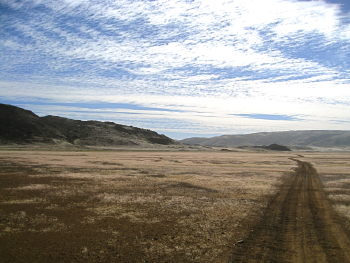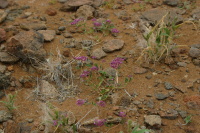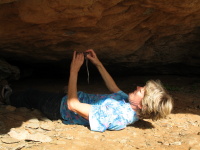Notes from the bottom left
Messum again
May 2008
You would think that a flat crater of some 400 square kilometres would be quite simple to find, particularly as only a few monthsbefore we had been there. But it wasn’t. And this time the old GPS for some reason was not giving the readout of the position.

But suddenly there it was. 400 Square kilometres of absolutely flat grassland at haytime. Silver. In the middle of the desert. Quelea finches cheeping everywhere in huge numbers. The world’s biggest and most perfect cricket pitch. The only cricket pitch in the world with Welwitchias round the boundary.
The Messum is not far from the sea and sea mists are quite frequent at night. A big one rolled in that night. As we woke it was beginning to burn off.

This mist is the lifeblood of the desert ecology. Its pretty well all the water there is except in exceptional years when it rains a bit. We spent a while photographing it, an odd thing for a Brit to do really.

They say that the Welwitchia gets its water from this mist; it flows down to the end of the leaf where it is taken up by fine surface roots. I dont believe it. Firstly, it does not flow and secondly when it gest to the split ends it would get lost. The Welwitchia gets its water from a long tap root into the aquifer
There was no sign of the droplets flowing or being absorbed by this Welwitchia leaf
A termite mound being made inthe misty morning. What do they do in the years when there is no rain?
These dont have the attraction of the Namaqualand flowers but the extraordinary thing about these is simply that they were there, within a few metres of each other in the middle of a desert. Like the grass they are short fast-growing annuals that get the reprodution thing over as soon as possible before they die of thirst
I've not identified them yet but they look like common Damaraland plants but shorter.
We found the rock art we missed last time but that we had been told about. Well I didn’t because of my colourblindness. But, as always, I just point the camera at a bare rock face, look at it in the viewer and lo, it’s suddenly covered in little dancing men.
The little dancing men here were interesting because (a) they were ony dancing men; no (or few) animals and (b) they were little; most less than 20cm high and (c) they were on the underside of a horizontal face; not easy to spot.
What is this; about 20cm high?
This art bears no comparison with that to be found all over the Brandberg, 40km to the east. But the interesting thing is that it is here at all in a place where there seems to be no water supply. Was the climate wetter in the past?
Dedicated Ministry of Education researcher finds evidence that HIV may have been in Namibia a little earlier than previously thought

It was the May holiday and we had planned to climb the Brandberg. Conditions were perfect, there had been a lot of rain and there would be plenty of water up there. Unfortunately our condition was not that perfect as we had both had a nasty cold and we were blowing climbing even up the drive. So we returned to the Messum instead.
The Messum crater is in a part of Namibia that has been severely knocked around over the last 500 million yeas. Firstly the collision of a bit of early Gondwana that was later to become Argentina with the main African block caused some massive folding of a whole lot of sedimenatary rocks so they were left concertina-like just north of what is now the Brandberg (a lump of granite which pushed its way through this mess much later). This concerinarock is now mainly worn down so that it is now many kilometres of exposed sedimentary layers lying on their sides.
The Messum came about 200 million years ago when Argentina started wandering off from Walvis Bay. It was a big shallow volcano about 20km across that bubbled away for may years, heated by a hot spot in the earths crust that is now under Tristan da Cunha.
We returned to it because we wanted to see what happens to it when it rains in it which it sometimes does. And which this year, it had done in abundance.



















